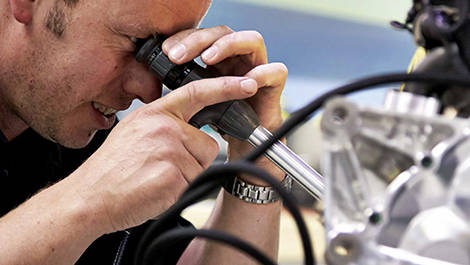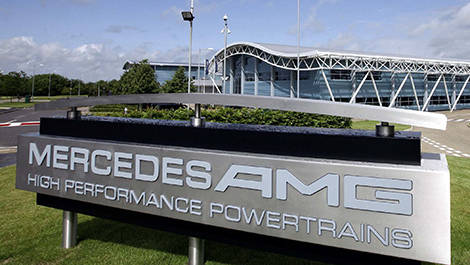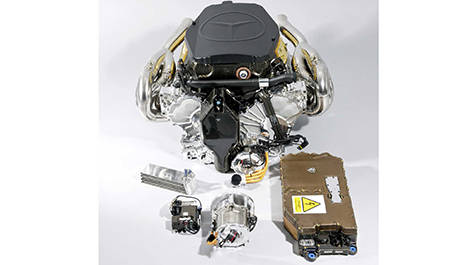Assembling a Formula 1 turbo hybrid power unit is a painstaking process that's not unlike fine watchmaking. There are numerous components involved, all smaller than the other, and highly complex electronic systems.
The heart of this power unit is a 1.6L gasoline engine with direct injection, a turbocharger, a rechargeable battery, and a pair of energy recuperation systems using two electric motors — the MGU-H, which collects exhaust energy, and the MGU-K, which captures kinetic energy during braking.
In Mercedes AMG's case, the power units are designed, built and tested inside the headquarters of Mercedes AMG High Performance Powertrains.
Low-key suppliers
This is where it all comes together for the Mercedes F1 power units, codenamed PU106A, although several key components (pistons, crankshafts, connecting rods, etc.) are outsourced from ultra-specialized suppliers.
Reliability is crucial this year since drivers have just five power units at their disposal for the entire season.
The Brixworth plant employs 500 people including 450 in a technical role (engineers, machinists, builders, etc.).
A full turbo hybrid power unit weighs at least 145 kilograms and consists of around 7,000 parts made of composite, steel, aluminum, titanium, or magnesium.
For obvious reasons, each power unit is conscientiously assembled with perfect components that have all previously passed rigorous quality checks.
A team of 12 technicians works for about 250 hours to a build and finish a single power unit.
Due to the turbocharger, pressure inside the combustion chamber is huge. In fact, it's twice as high as the pressure inside the old, naturally aspirated V8 engine.
Mind-numbing numbers
With chamber pressure reaching up to 200 bars (200 times higher than ambient pressure), the burden on the crankshaft and pistons is equally massive.
At 12,000 rpm, the pistons go from 0-37 m/s 400 times per second, which translates into a speed of 130 km/h. Meanwhile, the turbine inside the turbocharger can spin at 100,000 rpm, or 1,500 revs per second!
Given these gigantic forces, flawless lubrication and the absence of leaks are instrumental in ensuring the reliability of the power units.
While certain parts like the middle section of the piston ring are lubricated with a good 2-3 microns thick of oil, other moving parts like the timing belt have just a few thousandths of a micron.
Mercedes AMG uses a special oil formula that reduces internal friction and maximizes output during combustion, while contributing to the engine's cooling efficiency and delivering reliable performance.
Once a power unit is assembled, it undergoes a process, which Mercedes calls “Break In, Pass Off” (BIPO). There, on a test bed equipped with a brake, engineers literally break the engine in by revving it up in specific cycles. As metal expands due to the increased temperature, the various parts properly fit together.
They later crank things up by reaching higher engine speeds to validate every operating parameter. One last visual check, and off the power unit goes to work, either for Mercedes AMG or another team using Mercedes as an engine supplier.
Sealed and delivered
After a Grand Prix, F1 teams don't dismantle and check up the power units like they do in other series. Instead, FIA officials seal them, which means the technicians in Brixworth can only perform a visual inspection using an endoscope, and work on the parts that haven't been sealed.
For confidentiality purposes, Mercedes refuses to disclose the total number of power units that are built throughout the year, including the five units per driver and all the others used for testing.
However, we do know that the German manufacturer sends at least 20 turbo hybrid power units to its four teams on any given Grand Prix — one for each driver, a spare one, and a few extra units.
The heart of this power unit is a 1.6L gasoline engine with direct injection, a turbocharger, a rechargeable battery, and a pair of energy recuperation systems using two electric motors — the MGU-H, which collects exhaust energy, and the MGU-K, which captures kinetic energy during braking.
In Mercedes AMG's case, the power units are designed, built and tested inside the headquarters of Mercedes AMG High Performance Powertrains.
Low-key suppliers
This is where it all comes together for the Mercedes F1 power units, codenamed PU106A, although several key components (pistons, crankshafts, connecting rods, etc.) are outsourced from ultra-specialized suppliers.
 |
| Visual inspection of the combustion chambers using an endoscope. (Photo: Mercedes-Benz) |
Reliability is crucial this year since drivers have just five power units at their disposal for the entire season.
The Brixworth plant employs 500 people including 450 in a technical role (engineers, machinists, builders, etc.).
A full turbo hybrid power unit weighs at least 145 kilograms and consists of around 7,000 parts made of composite, steel, aluminum, titanium, or magnesium.
For obvious reasons, each power unit is conscientiously assembled with perfect components that have all previously passed rigorous quality checks.
A team of 12 technicians works for about 250 hours to a build and finish a single power unit.
Due to the turbocharger, pressure inside the combustion chamber is huge. In fact, it's twice as high as the pressure inside the old, naturally aspirated V8 engine.
Mind-numbing numbers
With chamber pressure reaching up to 200 bars (200 times higher than ambient pressure), the burden on the crankshaft and pistons is equally massive.
At 12,000 rpm, the pistons go from 0-37 m/s 400 times per second, which translates into a speed of 130 km/h. Meanwhile, the turbine inside the turbocharger can spin at 100,000 rpm, or 1,500 revs per second!
 |
| Mercedes AMG High Performance Powertrains workshops. (Photo: Mercedes-Benz) |
Given these gigantic forces, flawless lubrication and the absence of leaks are instrumental in ensuring the reliability of the power units.
While certain parts like the middle section of the piston ring are lubricated with a good 2-3 microns thick of oil, other moving parts like the timing belt have just a few thousandths of a micron.
Mercedes AMG uses a special oil formula that reduces internal friction and maximizes output during combustion, while contributing to the engine's cooling efficiency and delivering reliable performance.
 |
| The many components of the Mercedes Power Unit. (Photo: Mercedes-Benz) |
Once a power unit is assembled, it undergoes a process, which Mercedes calls “Break In, Pass Off” (BIPO). There, on a test bed equipped with a brake, engineers literally break the engine in by revving it up in specific cycles. As metal expands due to the increased temperature, the various parts properly fit together.
They later crank things up by reaching higher engine speeds to validate every operating parameter. One last visual check, and off the power unit goes to work, either for Mercedes AMG or another team using Mercedes as an engine supplier.
Sealed and delivered
After a Grand Prix, F1 teams don't dismantle and check up the power units like they do in other series. Instead, FIA officials seal them, which means the technicians in Brixworth can only perform a visual inspection using an endoscope, and work on the parts that haven't been sealed.
For confidentiality purposes, Mercedes refuses to disclose the total number of power units that are built throughout the year, including the five units per driver and all the others used for testing.
However, we do know that the German manufacturer sends at least 20 turbo hybrid power units to its four teams on any given Grand Prix — one for each driver, a spare one, and a few extra units.


